|
Bishop Duppa's Almshouses The Vineyard, Richmond, TW10 6AJ |
The almshouses were originally built in Friars Stile Lane in 1661 by the Bishop of Winchester, Brian Duppa, after the Restoration. The site had been chosen as it was the place where the Bishop's life had been saved as he was being pursued by some of Cromwell's adherents. Bishop Duppa had been tutor to Charles, Prince of Wales, who later became Charles II, and he had vowed that if his pupil was restored to the throne, he would found almshouses in thanksgiving.
The red brick building contained 10 almshouses under one roof. Above its entrance was an inscribed stone tablet reading: Votiva tabula. I will pay my vows which I made to God in my trouble. Each almshouse contained two rooms. The 10 poor unmarried women aged 50 years or over were elected by the minister and the vestry of the parish.
To provide financial support for the almswomen, the Bishop settled the rental of a farm and other properties at Lower Halliford, near Shepperton, Middlesex.
In the early 1800s each almswoman received 10 shillings (50p) a month and £1 a year for coals.
By the 1820s the monthly stipend had increased to £1, with an additional £1 at Midsummer and Christmas. Also at Christmas the almswomen were given "a Christmas repast of a barn-door fowl and a pound of bacon", secured to them by the lease of the farm at Shepperton. Each year six and a half chaldrons of coal were distributed amongst them. Every other year they each received a gown made of substantial cloth and of a colour known as Bishop's blue. The cost of the ten gowns was £16. In years when gowns were not given out, the women received £5 distributed between them.
By the early 1820s, however, the buildings were beginning to decay and required substantial repair. In the 1840s, when they had further dilapidated, James Ewing, the owner of Downe House on Richmond Hill, proposed a deal. He wished to expand his garden and offered to rebuild the almshouses elsewhere in exchange for the original site. He provided a plot of land adjacent to Queen Elizabeth's Almshouses in The Vineyard and also paid for the rebuilding work.
The new almshouses opened in 1851. The Jacobean-style building, built of grey brick and stone, had a central archway which led to the garden at the back. On either side of this archway were five almshouses.
During WW2 (1939-1945) the left-hand side of the building was damaged by bombs.
The almshouses were Grade II listed in 1950.
In 1987 Bishop Duppa's Almshouse Charity became part of the Richmond Charities.
Current status
The almshouses continue in use as retirement housing, providing ten single-bedroom apartments. New residents are accepted from the age of 65 years.N.B. Photographs obtained in March 2020
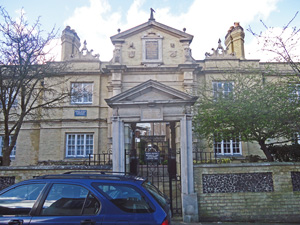
The front arch and gateway (above and below) were relocated from the original almshouses.
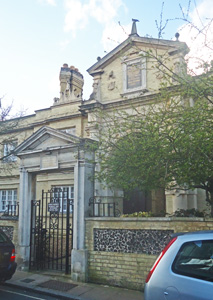
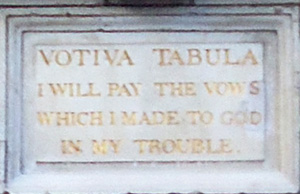
The original stone tablet is mounted on the entrance arch.
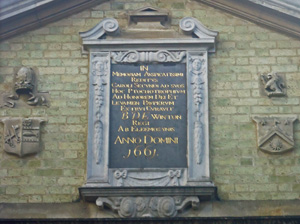
A stone tablet mounted on the central portion of the almshouses declares: In memoriam auspicatissimi reditus Caroli secondi ad suos hoc ptochotrophium ad honorem Dei et levamen pauperum ex trui curavit BDE Winton regi ab eleemos unis Anno Domini 1661.
(In memory of the most fortunate return of Charles II to his people Bishop Brian Duppa of Winchester erected this almshouse to the honour of God and as relief for the poor by the charity of the king. Anno Domini 1661)
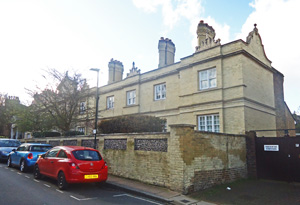
The eastern section of the almshouses (above) and the western (below).
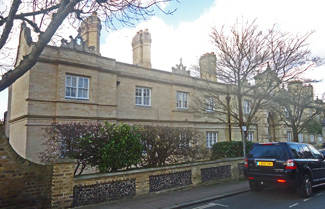
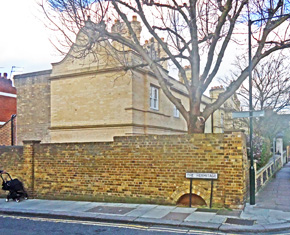
The western part of the building was damaged during the war.
References (Accessed 30th January 2021)
(Author unstated) 1815-1839 Bishop Duppa's Almshouse. Reports of the Commisioners Appointed in Pursuance of Acts of Parliament 33, 615-620.
Brayley EW 1841 A Topographical History of Surrey, Vol. 3. London, David Rogue, p.92.
Hakewell AP 1849 Bishop Duppa's Almshouses. The Builder 7 (330), 259.
Hughson D 1808 London, Vol. 5. London, J Stratford, p.380.
https://britishlistedbuildings.co.uk
https://en.wikipedia.org
https://en.wikisource.org
https://historicengland.org.uk
https://housingcare.org
https://izi.travel
https://libraryblog.lbrut.org.uk
https://rcalms.wordpress.com
www.alamy.com
www.british-history.ac.uk
www.exploringsurreyspast.org.uk
www.london-footprints.co.uk
www.mydoramac.com
www.richmond.gov.uk
www.richmondcharities.org.uk
www.thevineyardrichmond.info
Last updated 19th February 2021
Click here to return to Almshouses of London alphabetical list
Click here to return to home page